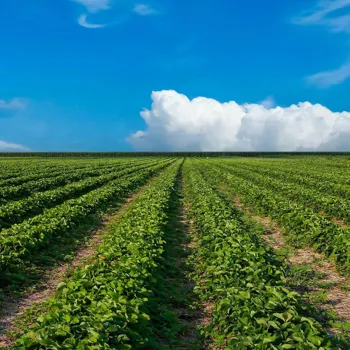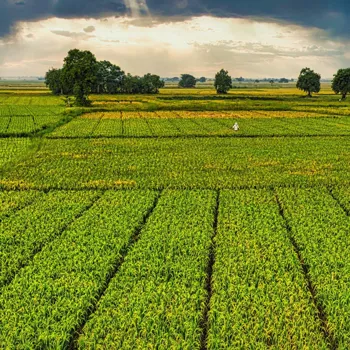Unlocking the Future of Agriculture with Genetics: Read how science is shaping resilient, productive, and nutritious crops
Agriculture, the backbone of India's economy, is facing immense pressure. Climate
change, shrinking land resources, and a growing population all demand that we produce more food with less. Thankfully, science is stepping up to the plate, and one of the most promising tools is genetics.
By understanding the genetic makeup of plants, we can breed crops that are more resilient, more productive, and more nutritious, ensuring food security for generations to come.
Farmers use selective breeding to improve crop traits
For ages, farmers have selected the best seeds, generation after generation. This traditional method, called selective breeding, is basically a form of genetic manipulation, though done without knowing the exact science behind it.
By choosing plants with desirable traits like bigger fruits or drought resistance, farmers have gradually improved their yields. Agriculture depends significantly on new breeding technologies for improving crop productivity, quality, and resistance to biotic and abiotic stresses.
These technologies help to accelerate that process.
Modern genetics enables precise breeding for desirable traits
Modern genetics takes this to a whole new level. Scientists can now identify the specific genes responsible for desirable traits. This allows for much more precise and efficient breeding.
Imagine being able to pinpoint the exact gene that makes a rice plant resist a common disease, and then selectively breed other rice plants to have that gene as well.
Techniques: marker-assisted selection vs. genetic modification in plant breeding
This is where techniques like marker-assisted selection (MAS) and genetic modification (GM) come in. MAS uses DNA markers to identify plants carrying specific genes, making the breeding process faster and more accurate. GM, on the other hand, involves directly inserting genes into a plant's DNA.
It's important we look at the difference between both.
Marker-assisted selection streamlines plant breeding with DNA markers
Marker-assisted selection (MAS) is like having a GPS for plant breeding. Instead of just looking at the plant and guessing if it has the traits you want, MAS lets you check its DNA for specific markers linked to those traits.
Let's say you want to breed a variety of tomatoes that are resistant to a particular fungus. Instead of planting lots of different tomato plants and waiting to see which ones get sick, you can take small samples from their leaves and analyze their DNA.
If a plant has a specific marker that is known to be linked to resistance, you know it's worth investing in that plant. You can then focus on breeding it with other plants that also have the marker, to quickly produce more resistant tomatoes.
This saves time, money, and resources compared to traditional breeding methods.
Genetic Modification (GM)
While MAS speeds up traditional breeding, genetic modification, often wrongly confused to as genetically engineered, gets very specific about introducing new traits. Unlike changing the look of the plant, genes are added to make a plant produce toxins to kill pests.

Now, in order to grow these plants, farmers may not need to have to use pesticides. It helps to reduce costs and also protect the environment. For instance, Bt cotton, containing a gene from Bacillus thuringiensis, resists bollworms, a major cotton pest.
The downside to using the process of genetic modification is there are still some concerns. As we move along to use GM technology, we must ensure that it is done sustainably and safely, with proper regulations and constant assessment.
Genetics key to developing climate-resilient crops
Climate change is one of the biggest challenges facing agriculture today. Rising temperatures, unpredictable rainfall, and increased incidents of droughts and floods are threatening crop yields across the country.

Genetics offers a powerful way to develop climate-resilient crops that can withstand these stresses.
Scientists develop genes for drought and heat resistance in crops
For instance, scientists are working to identify genes that confer drought resistance in crops like rice and wheat. By incorporating these genes into existing varieties, they can create plants that can survive longer periods without water.

Similarly, genes that provide tolerance to high temperatures can help crops thrive even in the face of rising temperatures. Rice varieties that can withstand submergence during floods are very useful for flood-prone areas like Bihar and Assam.
Genetics can enhance crop nutrition for malnutrition in India
Beyond increasing yields and resilience, genetics can also be used to improve the nutritional value of crops. This is particularly important in India, where malnutrition is a major public health problem.
Biofortification involves enhancing the levels of essential vitamins and minerals in crops through breeding.
Golden Rice and biofortified crops combat nutrient deficiencies worldwide
One successful example is Golden Rice, which has been genetically engineered to produce beta-carotene, a precursor to vitamin A. Vitamin A deficiency is a major problem in many parts of the world, and Golden Rice offers a way to combat this deficiency.
Similarly, scientists are working to develop iron-rich varieties of rice and pulses to address iron deficiency anemia. By making our staple foods more nutritious, we can improve the health and well-being of millions.
Research is also being conducted in areas of breeding crops that have low sugar, which can benefit dietic patients.
Genetics in agriculture: Potential and challenges of GM crops
While the potential of genetics in agriculture is immense, there are also challenges that need to be addressed. GM crops are subject to stringent regulations, and public perception of these crops remains mixed.
Many people worry about the safety of GM foods and their potential impact on the environment. Clear communication and transparency are essential to building public trust in GM technology.
Genetic research benefits must reach smallholder farmers for sustainable agriculture
Another challenge is ensuring that the benefits of genetic research reach smallholder farmers. Often, new and improved varieties are only accessible to larger farmers who can afford the seeds and inputs.
It is important to develop and promote varieties that are affordable and suitable for the needs of smallholder farmers. More investment is needed on agriculture.
Genetics revolutionizes agriculture for food security in India
Genetics is revolutionizing agriculture, offering new solutions to the challenges of food security and climate change. By understanding and manipulating the genetic makeup of crops, we can breed plants that are more productive, more resilient, and more nutritious.

While challenges remain, the potential of genetics to transform agriculture is undeniable. With continued research, development, and responsible implementation, genetics can play a vital role in ensuring a food-secure future for India.
AI Generated Content. Glance/InMobi shall have no liability for the content










